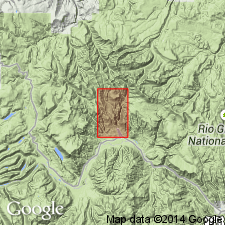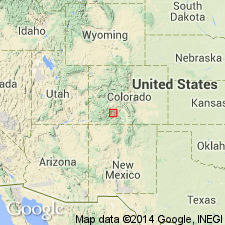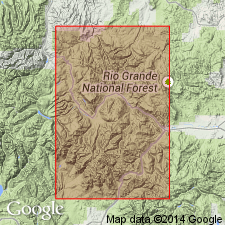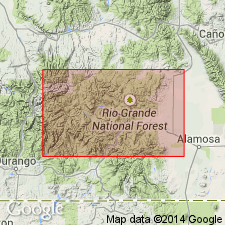
- Usage in publication:
-
- Willow Creek rhyolite*
- Modifications:
-
- Original reference
- Dominant lithology:
-
- Rhyolite
- AAPG geologic province:
-
- San Juan Mountains province
Summary:
Willow Creek rhyolite of Alboroto group of Potosi volcanic series. The thick series of flows of fluidal felsitic rhyolites characteristically exposed above Creede in the canyons of both forks of Willow Creek, [Creede mining district, San Luis Peak 7.5-min quadrangle, Mineral County, Rio Grande National Forest, southwestern Colorado], is here named Willow Creek rhyolite. Thickness 0 to 2,000+ feet. Is a formation in Alboroto group, of Potosi volcanic series. Unconformably underlies Campbell Mountain rhyolite and unconformably overlies Outlet Tunnel quartz latite. It is possible latter formation represents a lens between flows of Willow Creek rhyolite, but this is not believed probable. Age is Miocene.
Source: US geologic names lexicon (USGS Bull. 896, p. 2343).

- Usage in publication:
-
- Willow Creek Member*
- Modifications:
-
- Revised
- AAPG geologic province:
-
- San Juan Mountains province
Summary:
Reduced in the San Juan Mountain province in stratigraphic rank as a formation (Emmons and Larsen, 1923) and assigned to the Bachelor Mountain Rhyolite as its basal member. Assigned a middle or late Tertiary age.
Source: GNU records (USGS DDS-6; Denver GNULEX).

- Usage in publication:
-
- Willow Creek Bed*
- Modifications:
-
- Revised
- Age modified
- AAPG geologic province:
-
- San Juan Mountains province
Summary:
Pg. A52-A53, A79. Willow Creek Bed of Bachelor Mountain Member of Carpenter Ridge Tuff. Reduced in stratigraphic rank from Willow Creek Member of Bachelor Mountain Tuff to Willow Creek Bed, basal bed of Bachelor Mountain Member (revised) of Carpenter Ridge Tuff (revised). Overlies outflow member of Carpenter Ridge; underlies Campbell Mountain Bed of Bachelor Mountain Member. Age changed from Oligocene --to-- late Oligocene.
Source: Publication.

- Usage in publication:
-
- Willow Creek zone*
- Modifications:
-
- Revised
- AAPG geologic province:
-
- San Juan Mountains province
Summary:
Revised to informal status and is referred to as lowermost of three zones within Bachelor Mountain Member of Carpenter Ridge Tuff. Restudy of Creede area, Mineral Co, CO, San Juan Mountain province, has shown that within central part of Bachelor caldera in San Juan volcanic field, unit represents lower zone of upward sequence of progressively less welded zones within thick rhyolitic caldera fill. At margins of caldera welding zones, alternate and interfinger complexly. Unit previously thought to be a discrete eruptive deposit. Grades upward into Campbell Mountain zone (revised to informal status) of Bachelor Mountain; younger than Fish Canyon Tuff. Oligocene age (27.35 Ma).
Source: GNU records (USGS DDS-6; Denver GNULEX).
For more information, please contact Nancy Stamm, Geologic Names Committee Secretary.
Asterisk (*) indicates published by U.S. Geological Survey authors.
"No current usage" (†) implies that a name has been abandoned or has fallen into disuse. Former usage and, if known, replacement name given in parentheses ( ).
Slash (/) indicates name conflicts with nomenclatural guidelines (CSN, 1933; ACSN, 1961, 1970; NACSN, 1983, 2005, 2021). May be explained within brackets ([ ]).

